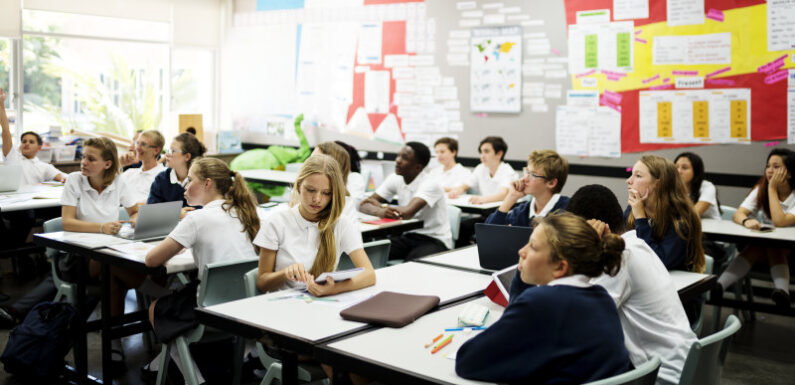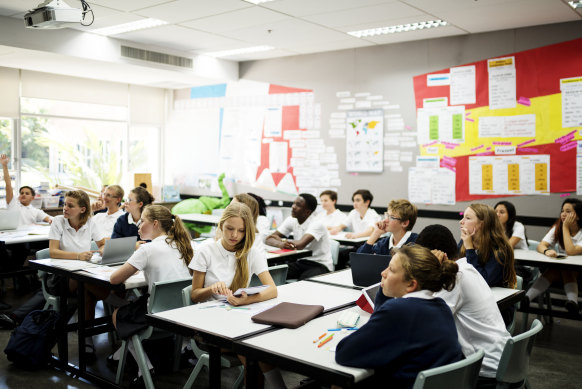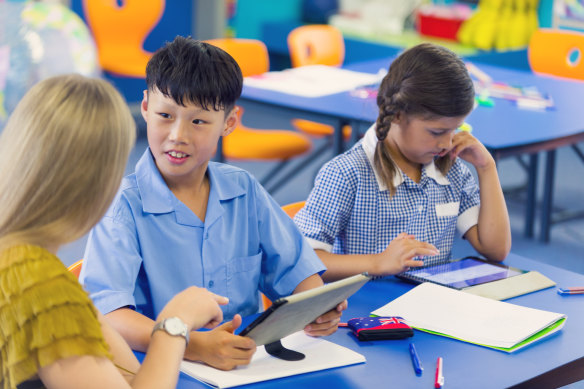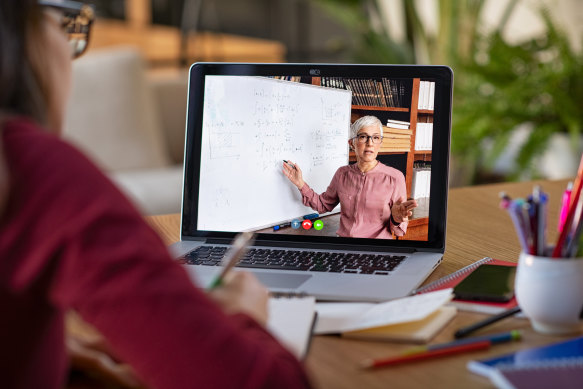
Save articles for later
Add articles to your saved list and come back to them any time.
Australia’s education system is rife with recurring themes.
There are continuing issues of funding inequity and disadvantaged students that fall further behind. The teaching workforce shortage grows worse and almost a third of Australian children now fail to meet new NAPLAN proficiency standards for literacy and numeracy.
Abolishing the ATAR is just one radical idea to improve learning and school retention rates.
If we’re going to change things, we need some radical thoughts.
This masthead asked a number of education experts for their biggest ideas to improve the system. Some of these ideas may be controversial, and many experts disagree, but all are already being practised successfully overseas.
Abolish the ATAR
In 2004, New Zealand abolished its tertiary entrance rankings, telling shell-shocked universities the aim of high school was not to prepare for tertiary education.
The National Certificate of Educational Achievement assessed students only as excellent, merit, achieved and not achieved. An excellent grade was classed as such regardless of whether it was in chemistry or panel beating.
Within three years, New Zealand’s high school retention rate climbed from 80 per cent to 92 per cent, schools became supporters rather than selectors and students thrived. These students included the sons of Professor John Hattie, one of Australia’s most influential education academics.
Hattie says in Australia, upper high schools are still entrenched in a 1960s model of sorting students for tertiary courses, privileging teachers of certain subjects and humouring parents who want to maximise their children’s chances of high Australian Tertiary Admission Ranks (ATARs).
The University of Melbourne scholar says senior high school remains the domain of the privileged, with entrenched superiority for certain subjects and a credentialing system that serves too few.
Hattie says the problem in Australia is that each state and territory, Catholic and independent jurisdiction wants tight control of senior school, coveting the prestige from high ATARs. Meanwhile, 20 per cent of students did not complete year 12 last year.
Hattie says what we should be doing is encouraging more children to stay in school longer.
“The evidence shows the greatest predictor of adult health, wealth and happiness is not achievement in schools but the number of years of schooling,” he says.
“One of the most serious problems in Australian schools is that one in five who start do not finish high school. The costs to them, their wealth, health and happiness and to society (let alone locking in the socio-economic status of their parents) is in serious jeopardy.“
Increasing class sizes could give teachers more time.
Increase class sizes
Australian teachers spend more hours in the classroom than their counterparts in other countries, yet receive little time for professional learning and preparation to meet ever-broadening demands of their jobs.
Katie Roberts-Hull from Think Forward Educators, an organisation that promotes the science of learning, says a possible solution lies in class sizes.
Australian teachers have an average of 20 face-to-face teaching hours each week and an average class of 22 students. This compares to 18 hours and 30 students in Singapore and Japan, 18 hours and 26 students in South Korea and 10-12 hours and more than 40 students in Shanghai.
A report from the Grattan Institute last year found class sizes could be increased by about three students, where appropriate, to “buy” two hours a week of extra preparation time, at very little or no cost.
In a survey done at the same time, teachers were mostly positive about small increases in class sizes in exchange for more preparation time. Between 59 per cent and 85 per cent of teachers generally agreed, depending on the existing class size. The report also said small changes in class sizes didn’t appear to affect student learning.
“This works better in schools with whole-school systems and well-managed classrooms because in these contexts, a slight change of two to three students won’t make a difference to student learning, but the saved hours will make a real difference for teachers,” Roberts-Hull says.
“Teachers could use the extra time for lesson preparation, professional learning, or engaging with individual students and families.”
Having the same teacher for sequential years can foster better relationships and improved results.Credit: iStock
Make the teachers repeat
As schools open for a new year and most teachers spend the first weeks getting to know their new classes, others simply welcome back their students and hit the ground running.
It’s a process known as “looping”, where teachers stay with students for multiple years, moving to each new grade’s curriculum with their class.
It’s not a new idea. Looping is widely practised in Finland and the United States, and is common in Australian Montessori and Steiner schools.
But Pasi Sahlberg, professor of educational leadership at the University of Melbourne, says it is surprising the practice is not more widespread, given it’s a nearly zero-cost way to build better relationships and improve the quality of children’s education.
“Studies on looping have found that healthy student-teacher relationships are associated with higher academic achievement, fewer disciplinary problems and decreased risky behaviour,” he says.
In Finland, the same teacher normally teaches the same class from preschool until the end of grade 2, then another takes the class until the end of grade 6. When Sahlberg taught high school maths there, he kept the same class for three years.
“As a teacher, I found that a great way to know my students better, build trust-based relationships with their parents and be more accurate in assessing their learning,” he says.
‘The notion of finding a new dentist or physician each year for every child seems absurd … Yet for many children, their schools assign them to a new teacher … every year.’
In the US, where up to 12 per cent of schools had adopted some form of looping by 2017-18, the nation’s school superintendents made a compelling argument for its efficacy: “The notion of finding a new dentist or physician each year for every child seems absurd … Yet for many of these same children, their schools assign them to a new teacher and require they learn a new set of classroom routines and adult expectations every year.”
Sahlberg says Australian schools are primarily designed to deliver curriculum rather than rethink schools as a good and safe place for children to learn and grow.
Teach less, go deeper
Memorised facts may be impressive during tests, but students will need more than rote learning to compete for the jobs of the future.
Education high performers like Finland, Estonia and Hong Kong have all streamlined their curricula to contain less content but more opportunities for deep conceptual understanding.
Australian Council for Educational Research CEO Geoff Masters says factual information is increasingly accessible through technology. The new challenge for schools is to equip young people to succeed in an uncertain future.
Masters led a review of the NSW curriculum in 2020, recommending a 30 per cent reduction in syllabus content in what then-premier Gladys Berejiklian said needed to be a “benchmark for change” to the education system.
A first-grade textbook in Estonia that was once 100 pages is now half the size. British Columbia’s grade 5 social studies curriculum was once 70 pages but is now summarised on a single page.
In downsizing their curricula, most jurisdictions have not simply removed content, they have reconstructed the objectives around a smaller number of more broadly defined student outcomes.
Attempts have been made to shift the balance of learning from individual facts to deeper understandings of a smaller number of essential concepts and principles. British Columbia’s current curriculum refers to these as “big ideas”.
“We have to get away from this industrial assembly line model that we have in the Australian school sector,” Masters says.
“Deep understanding invites a particular way of conceptualising learning success, not as the ability to demonstrate individual facts and routines, but as long-term growth in understanding and competence.”
Masters says Australian schools need to start thinking of learning and development as ongoing processes where new knowledge builds on prior lessons and lays the foundation for future learning.
“We really need an understanding of learning as continuous, accumulative and lifelong,” he says.
Engagement with video games can also advance young people’s digital competence, which will be essential for study and work of the future.Credit: iStock
Let them game
In 2010, the New York City Department of Education opened Quest to Learn, its first public 6-12 school based on the principles of game design.
The school was driven by educational research that showed games allow for some of the richest learning experiences. Games were at the core of the curriculum, allowing students to play the role of scientists and doctors as they explored cellular biology and the human body.
At the same time, Swedish school Viktor Rydberg put Minecraft Education Edition on the curriculum for all 13-year-olds.
Associate Professor Laura Scholes, of ACU’s Institute for Learning Sciences and Teacher Education, says Australia is primed for games-based learning.
A 2017 survey by the eSafety Commissioner revealed about six out of 10 children aged eight to 17 years old play multiplayer games online. This undoubtedly increased during the pandemic.
Scholes says educational games can improve students’ attitudes and approaches to learning. Engagement with video games can also advance young people’s digital competence, which will be essential for study and work of the future.
“Digital games are increasingly pervasive in contemporary life outside school for many young people, intersecting with their leisure, cultural practices, and multimodal literacies, however, there is a disconnect in experiences at school.”
Scholes says many teachers are alienated due to negative views of gaming but with better integration into the curriculum, gaming will become more important as schools advance their students’ digital competence.
The average teacher spends six hours a week just on creating and sourcing lesson materials, often relying on social media websites.Credit: iStock
Lessons for all
We have the national curriculum, which informs the state curricula, which each school then interprets to inform teachers on how to write their own lesson plans.
So, how do we know all students are learning what they need to?
Jordana Hunter from the Grattan Institute is urging the Australian government to establish an independent body modelled on EdReports, a not-for-profit organisation in the US that reviews curriculum material.
Trained teams of reviewers spend up to six months assessing each set of materials, evaluating each against evidence-based criteria and for usability in the classroom.
Hunter says Australian schools often don’t have access to curriculum materials they need to deliver effective, well-sequenced instruction throughout school.
A 2022 Grattan Institute survey of more than 2200 teachers and school leaders found about half are planning their classes on their own.
The average teacher spends six hours a week just on creating and sourcing lesson materials, often relying on social media websites. Only 15 per cent of teachers have access to a shared bank of high-quality curriculum material for all the subjects they teach.
Hunter says some governments are starting to invest more in creating curriculum materials but it is just as important that the materials are reviewed by an independent body.
EdReports has had a significant impact on the quality of curriculum materials available to American teachers. Across 42 different publishers, 87 sets of curriculum materials have been changed based on EdReports reviews.
“Governments have dramatically underestimated how much support teachers and schools need to develop high-quality curriculum materials on their own,” Hunter says.
“Curriculum materials need to be carefully sequenced year to year, so that students are supported to build up knowledge and skills in a logical order. Unfortunately, without careful whole-school planning, there is a real risk that students experience a ‘lesson lottery’, ending up with gaps in their learning or having repeated the same books, topics or excursions multiple times at schools.”
Most Viewed in National
From our partners
Source: Read Full Article




